Finite Element Study on the Shear Capacity of Traditional Joints between Walls Made of AAC Masonry Units
Abstract
1. Introduction
- Meso-modelling—This is a variation of the macro-model variety that, in an way analogous to the periodic microstructure, includes nonlinear relationships between the average stresses and the average deformations of an element consisting of masonry units and mortar layers that is equivalent to a given body of the same dimensions. In this approach, a basic cell (representative volume element [36]) is established. It contains all geometric and physical information regarding any type of wall component [37,38];
- Micro-model—This treats masonry as a heterogeneous material. Division into finite elements occurs within each material (mortar, masonry unit). Different, nonlinear behaviour of brick and mortar with possible consideration of the interaction between them is used. Such a wall model is commonly used for the analysis of small structures or detailed analysis.
2. Experimental Observations
2.1. Test Specimens and Test Set-Up
2.2. Experimental Results
3. Finite Element Modelling
3.1. Description of Model
3.2. Materials
3.2.1. Non-Linear Behaviour of AAC and Mortar
- in the first quarter of the coordinate system, the criterion is described by the equation of a circle with a radius equal to the uniaxial tensile strength ft:
- in the third quarter of the coordinate system:
- in the third quarter of the coordinate system:where is the material strength in biaxial compression, is the tensile strength of a material, α, β are the model parameters, α is the parameter determined on the basis of the initial values of yield strength in uniaxial and biaxial compression, β is the parameter dependent on the hardening variable κ, determined on the basis of the proportion of the initial values of uniaxial yield strengths in compression and tension.
3.2.2. Compressive and Tensile Behaviour of AAC and Mortar
4. Finite Element Results and Discussion
4.1. Verification of the Reference FE Model
4.2. Sensitivity Analysis
5. Conclusions
- The 2D nonlinear model developed is capable of producing accurate results and predicting the load at initial cracking and the maximum load together with corresponding relative displacements between the walls with a reasonably good accuracy.
- From the sensitivity studies, it was found that the variation of elastic modulus, tensile strength and fracture energy of AAC is most critical to the results of the simulations (FE curve). It was also found that variation of Poisson’s ratio and compressive strength has negligible effect on the results.
Author Contributions
Funding
Conflicts of Interest
References
- Kotlarz, P. The Birth of Civilization. Culture Foundation; WOBEC: Gdansk, Poland, 2020; ISBN 978-83-950839-2-1. (In Polish) [Google Scholar]
- History of Brickmaking; Encyclopædia Britannica, Inc.: Chicago, IL, USA, 2003.
- Misiewicz, L. The market of building materials for raising walls in Poland in 2019. Build. Mater. 2020, 4, 8–9. (In Polish) [Google Scholar]
- Homann, M. Porenbeton Handbuch. Planen und bauen Mit System. 6. Auflage Hannover; Bauverlag: Gütersloh, Germany, 2008; ISBN 13-978-3-7625-3626-0. [Google Scholar]
- Drobiec, Ł. Analysis of AAC walls subjected to vertical load. Mauerwerk 2019, 23, 387–403. [Google Scholar] [CrossRef]
- Paganoni, S.; D’Ayala, D. Testing and design procedure for corner connections of masonry heritage buildings strengthened by metallic grouted anchors. Eng. Struct. 2014, 70, 278–293. [Google Scholar] [CrossRef]
- Maddaloni, G.; Balsamo, A.; Di Ludovico, M.; Prota, A. Out of Plane Experimental Behavior of T-Shaped Full Scale Masonry Orthogonal Walls Strengthened with Innovative Composite Systems. In Proceedings of the Fourth International Conference on Sustainable Construction Materials and Technologies, Las Vegas, NV, USA, 7–11 August 2016. [Google Scholar]
- Maddaloni, G.; Di Ludovico, M.; Balsamo, A.; Prota, A. Out-of-plane experimental behaviour of T-shaped full scale masonry wall strengthened with composite connections. Compos. Part B Eng. 2016, 93, 328–343. [Google Scholar] [CrossRef]
- Castro, L.O.; Alvarenga, R.D.C.S.; Silva, R.M.; Ribeiro, J.C.L. Experimental evaluation of the interaction between strength concrete block walls under vertical loads. Rev. Ibracon Estrut. Mater. 2016, 9, 643–681. [Google Scholar] [CrossRef]
- Corrêa, M.R.S.; Moreira, E.M.S.; Ramalho, M.A. Experimental Small-Scale Analysys of the Connections between Structural Clay Block Work Masonry Walls Submitted to Vertical Loads. In Proceedings of the 11th Canadian Masonry Symposium, Toronto, ON, Canada, 31 May–3 June 2009. [Google Scholar]
- PN-EN 1996-1-1:2010+A1:2013-05P. Eurocode 6: Design of Masonry Structures. Part 1-1: General Rules for Reinforced and Unreinforced Masonry Structures; CEN: Brussels, Belgium, 2005. (In Polish)
- Galman, I.; Jasiński, R. Joints in Masonry Walls. In Proceedings of the 6th International Conference on Autoclaved Aerated Concrete, Potsdam, Germany, 4–6 September 2018; Volume 2, pp. 339–346. [Google Scholar] [CrossRef]
- Jasiński, R.; Galman, I. Testing joints between walls made of AAC masonry units. Buildings 2020, 10, 69. [Google Scholar] [CrossRef]
- Galman, I.; Jasiński, R. Experimental Tests of Wall Joints. In Brick and Block Masonry—From Historical to Sustainable Masonry; CRC Press: London, UK, 2020; ISBN 978-0-367-56586-2. [Google Scholar]
- Caniato, M.; Bettarello, F.; Bonfiglio, P.; Gasparella, A. Extensive Investigation of Multiphysics Approaches in Simulation of Complex Periodic Structures. Appl. Acoust. 2020, 166, 107356. [Google Scholar] [CrossRef]
- Oñate, E.; Idelsohn, S.R.; Celigueta, M.A.; Rossi, R.; Marti, J.; Carbonell, J.M.; Ryzhakov, P.; Suárez, B. Advances in the Particle Finite Element Method (PFEM) for Solving Coupled Problems in Engineering. In Particle-Based Methods; Oñate, E., Owen, R., Eds.; Springer: Dordrecht, The Netherlands, 2011; Volume 25, pp. 1–49. [Google Scholar] [CrossRef]
- Zienkiewicz, O.C.; Taylor, R.L.; Nithiarasu, P.; Zhu, J.Z. The Finite Element Method; McGraw-Hill: New York, NY, USA, 1977. [Google Scholar]
- Chen, W.F. Plasticity for Reinforced Concrete; McGraw-Hill Book Company: New York, NY, USA, 1982. [Google Scholar]
- Jirásek, M.; Bazant, Z.P. Inelastic Analysis of Structures; John Wiley & Sons Ltd.: Hoboken, NJ, USA, 2002. [Google Scholar]
- Nasiri, E.; Liu, Y. Development of a detailed 3D FE model for analysis of the in-plane behaviour of masonry infilled concrete frames. Eng. Struct. 2017, 143, 603–616. [Google Scholar] [CrossRef]
- Wendner, R.; Vorel, J.; Smith, J.; Hoover, C.G.; Bažant, Z.P.; Cusatis, G. Characterization of concrete failure behavior: A comprehensive experimental database for the calibration and validation of concrete models. Mater. Struct. 2015, 48, 3603–3626. [Google Scholar] [CrossRef]
- Lemos, J.V. Discrete Element Modeling of the Seismic Behavior of Masonry Construction. Buildings 2019, 9, 43. [Google Scholar] [CrossRef]
- Rasulo, A.; Pelle, A.; Lavorato, D.; Fiorentino, G.; Nuti, C.; Briseghella, B. Finite Element Analysis of Reinforced Concrete Bridge Piers Including a Flexure-Shear Interaction Model. Appl. Sci. 2020, 10, 2209. [Google Scholar] [CrossRef]
- Marcon, M.; Vorel, J.; Ninšcević, K.; Wan-Wendner, R. Modeling Adhesive Anchors in a Discrete Element Framework. Materials 2017, 10, 917. [Google Scholar] [CrossRef] [PubMed]
- Ceroni, F.; Darban, H.; Luciano, R. Analysis of bond behavior of injected anchors in masonry elements by means of Finite Element Modeling. Compos. Struct. 2020, 241, 112099. [Google Scholar] [CrossRef]
- Christou, G.; Ungermann, J.; Wolters, K.; Hegger, J.; Claßen, M. Ermüdung von Verbunddübelleisten. Analyse und Modellentwicklung. Beton Und Stahlbetonbau 2020, 115, 355–363. [Google Scholar] [CrossRef]
- Litewka, A.; Szojda, L. Damage, Plasticity and failure of ceramics and cementitious composites subjected to multi-axial state of stress. Int. J. Plast. 2006, 22, 2048–2065. [Google Scholar] [CrossRef]
- Jasiński, R. Numerical analysis of the strains and stress states reinforced clay brick masonry walls horizontally sheared. Manag. Res. 2018, 5, 20–37. [Google Scholar] [CrossRef]
- Drobiec, Ł.; Jasiński, R. Adoption of the Willam-Warnke failure criterion for describing behavior of Ca-Si hollow blocks. Proced. Eng. 2017, 193, 470–477. [Google Scholar] [CrossRef]
- Jasiński, R. Proposal of procedure for identification of Menétrey–Willam (M-W-3) plasticity surface of homogeneous and hollow masonry units. Eng. Struct. Technol. 2019, 11, 40–49. [Google Scholar] [CrossRef]
- Jasiński, R.; Drobiec, Ł.; Mazur, W. Validation of selected non-destructive methods for determining the compressive strength of masonry units made of autoclaved aerated concrete. Materials 2019, 12, 389. [Google Scholar] [CrossRef]
- Lourenço, P.B. Computational Strategies for Masonry Structures. Ph.D. Thesis, Delf University, Delft, The Netherlands, 1996. [Google Scholar]
- Lourenço, P.B.; Rots, J.G.; Blaauwendraad, J. Two Approaches for the Analysis of Masonry Structures: Micro and Macro-Modeling. HERON 1995, 40, 313–340. [Google Scholar]
- Gambrotta, L.; Logomarsino, S. Damage models for the seismic response of trick masonry shear walls. Part I: The mortar joint model and its applications. Earthq. Eng. Struct. Dyn. 1997, 26, 423–439. [Google Scholar] [CrossRef]
- Gambrotta, L.; Logomarsino, S. Damage Models for the seismic response of trick masonry shear walls. Part II: The continuum model and its applications. Earthq. Eng. Struct. Dyn. 1997, 26, 441–462. [Google Scholar] [CrossRef]
- Chu, T.C.; Ranson, W.F.; Sutton, M.A.; Peters, W.H. Application of digital-image-correlation techniques to experimental mechanics. Exp. Mech. 1985, 25, 232–244. [Google Scholar] [CrossRef]
- Lord, J.D. Digital Image Correlation (DIC), Modern Stress and Strain Analysis: A State of the Art Guide to Measurement Techniques, BSSM; Evans, J.E., Dulie-Barton, J.M., Burguete, R.L., Eds.; Eureka Magazine: Cambridge, UK, 2009; pp. 14–15. [Google Scholar]
- Frankovský, P.; Virgala, I.; Hudák, P.; Kostka, J. The use of the digital image correlation in a strain analysis. Int. J. Appl. Mech. Eng. 2013, 4, 1283–1292. [Google Scholar] [CrossRef][Green Version]
- Lopez, J.; Oller, S.; Onnte, E.; Lubliner, J. A Homogeneous Constitutive Model for Masonry. Int. J. Numer. Methods Eng. 1999, 46, 149–156. [Google Scholar] [CrossRef]
- Lourenço, P.B.; Rots, J.G.; Blaauwendraad, J. Continuum Model for Masonry: Parameter Estimation and Validation. ASCE J. Struct. Eng. 1998, 124, 642–652. [Google Scholar] [CrossRef]
- Lourenço, P.B. On the Use of Homogenization Techniques for the Analysis of Masonry Structures. Mason. Int. 1997, 11, 26–32. [Google Scholar]
- Alfaiate, J.; De Almeida, J.R. Modelling Discrete Cracking on Masonry Walls. Mason. Int. J. Br. Mason. Soc. 2004, 17, 83–93. [Google Scholar]
- ABAQUS v.6.14 computer software and online documentation. In Dassault Systems; Simulia: Providence, RI, USA, 2019; Volume 505.
- Jasiński, R. Research and Modelling of Masonry Shear Walls; Silesian University of Technology: Gliwice, Poland, 2017; ISBN 978-83-7880-477-2. [Google Scholar]
- EN 1993-1-1. Eurocode 3: Design of Steel Structures—Part 1-1: General Rules and Rules for Buildings; CEN: Brussels, Belgium, 2005.
- Mrozek, D.; Mrozek, M.; Fedorowicz, J. The Protection of Masonry Buildings in a Mining Area. Proc. Eng. 2017, 193, 184–191. [Google Scholar] [CrossRef]
- Bedon, C.; Louter, C. Finite-element analysis of post-tensioned SG-laminated glass beams with mechanically anchored tendons. Glass Struct. Eng. 2016, 1, 39–59. [Google Scholar] [CrossRef]
- Lubliner, J.; Oliver, J.; Oller, S.; Onate, E. A plastic-damage model for concrete. Int. J. Solids Struct. 1989, 25, 299–326. [Google Scholar] [CrossRef]
- Lee, J.; Fenves, G.L. Plastic-damage model for cyclic loading of concrete structures. J. Eng. Mech. 1998, 124, 892–900. [Google Scholar] [CrossRef]
- Hillerborg, A.; Modeer, M.; Peterson, P.E. Analysis of crack formation and crack growth by means of fracture mechanics and finite elements. Cement Concrete Res. 1976, 6, 773–781. [Google Scholar] [CrossRef]
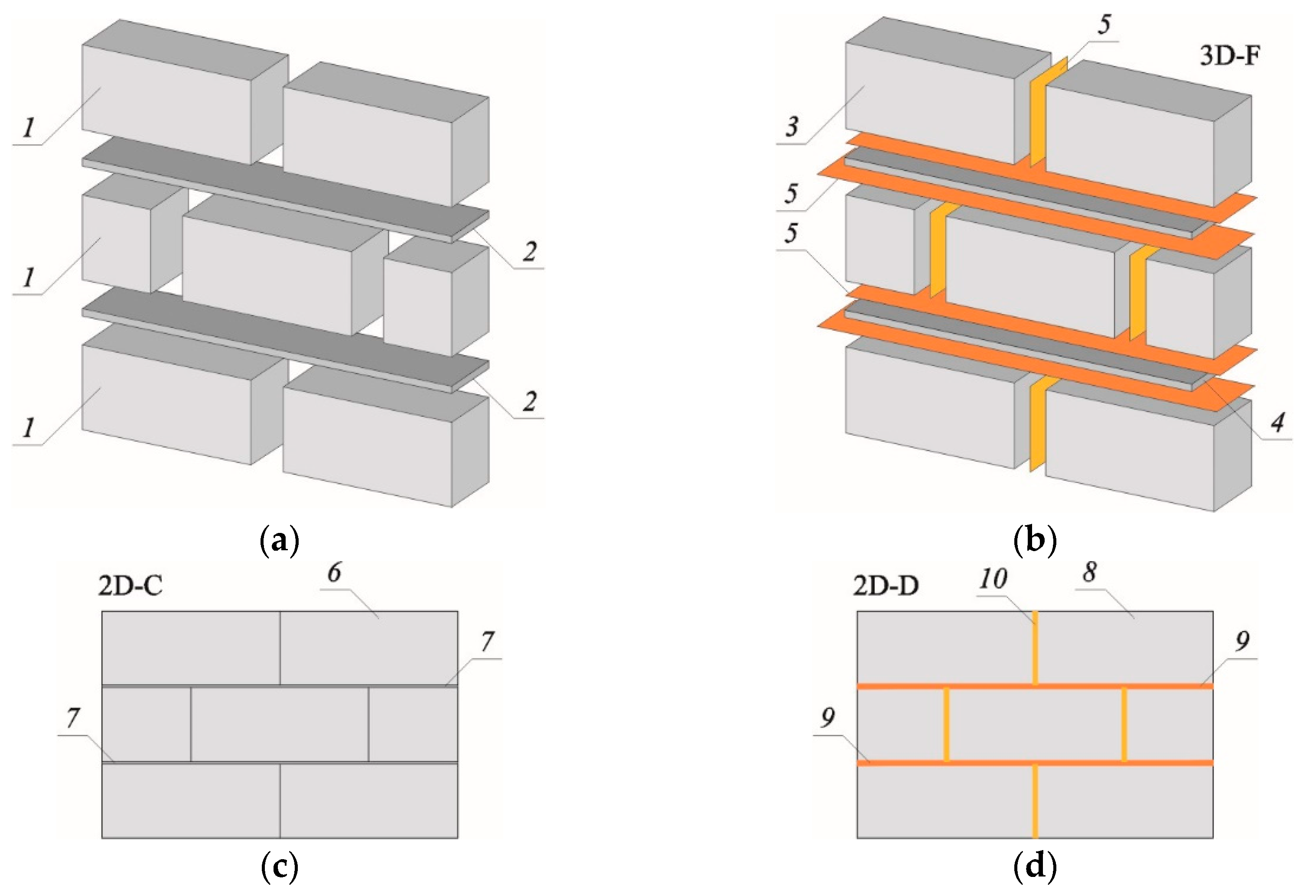


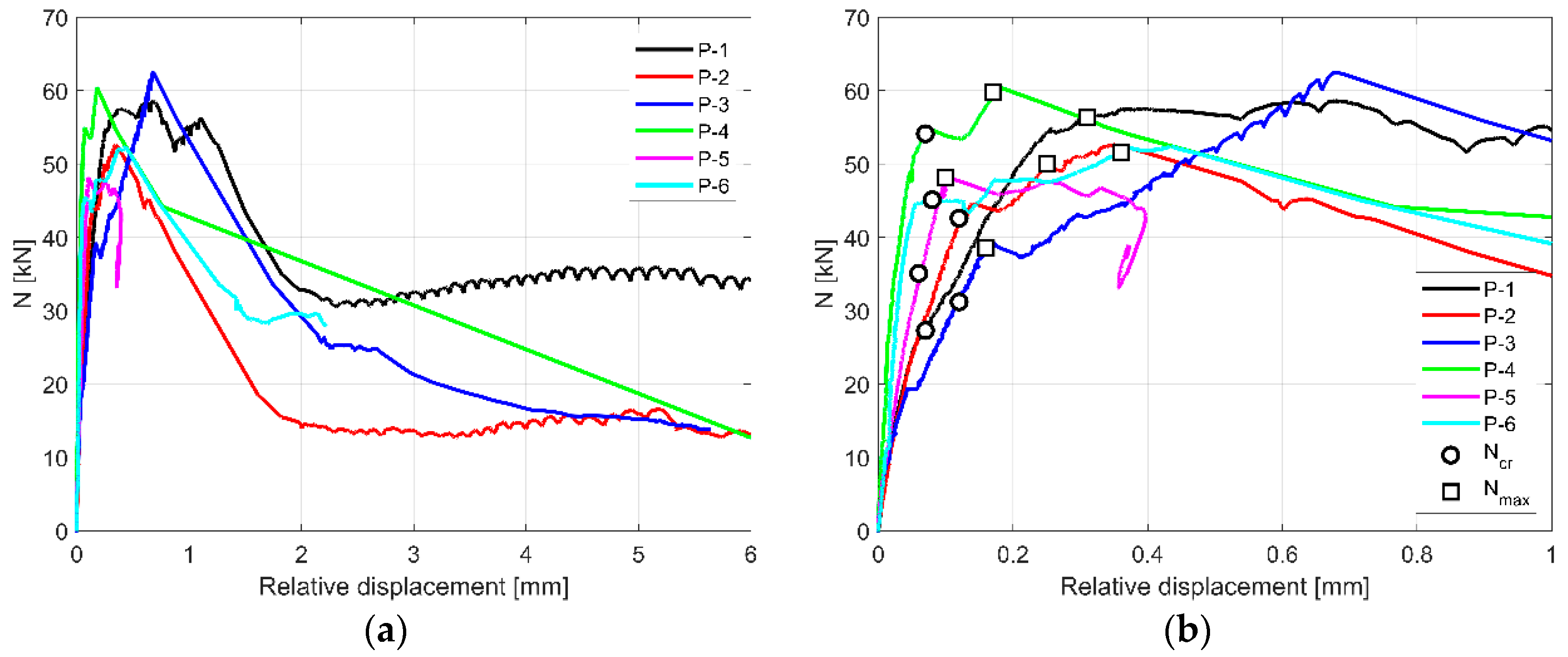

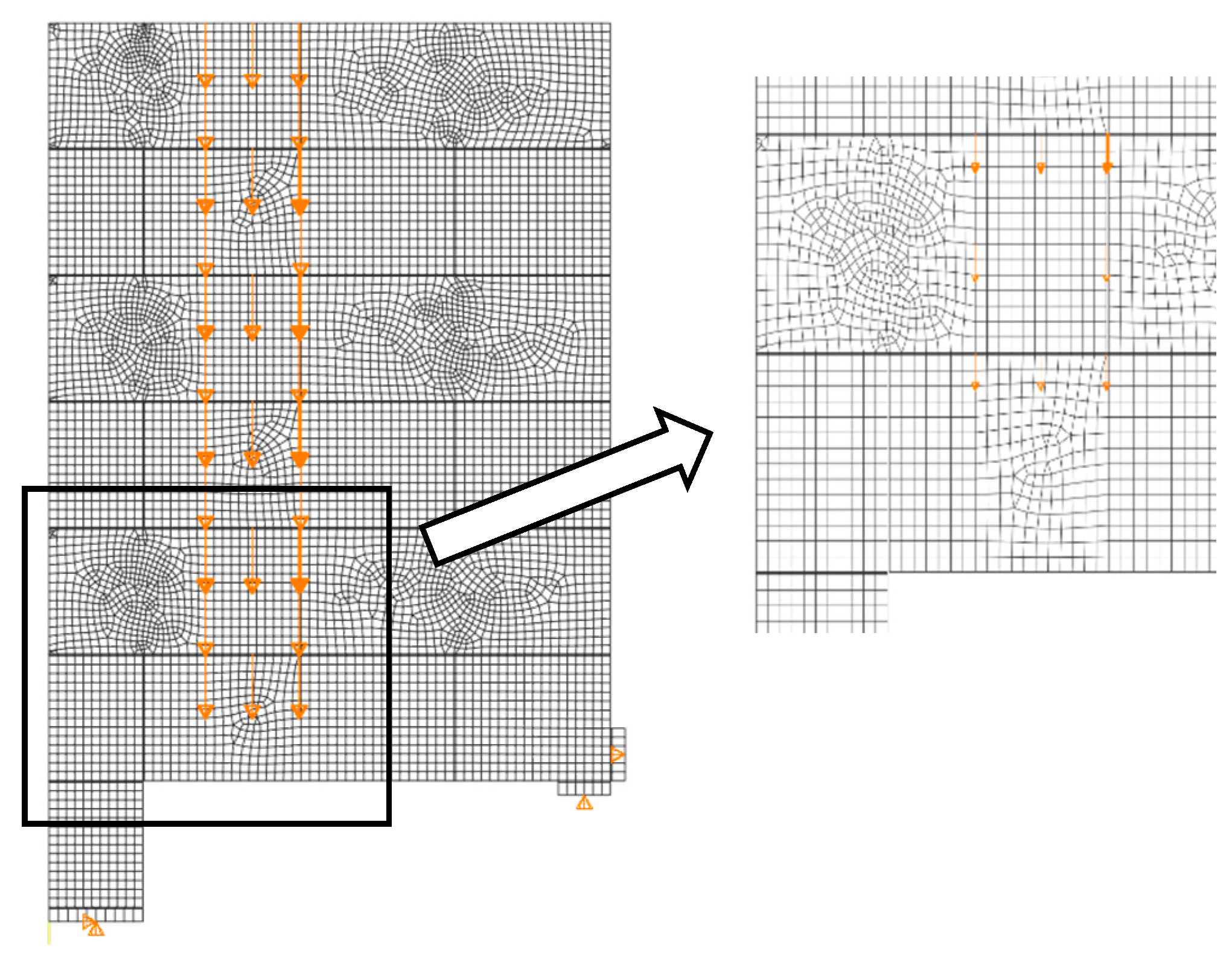
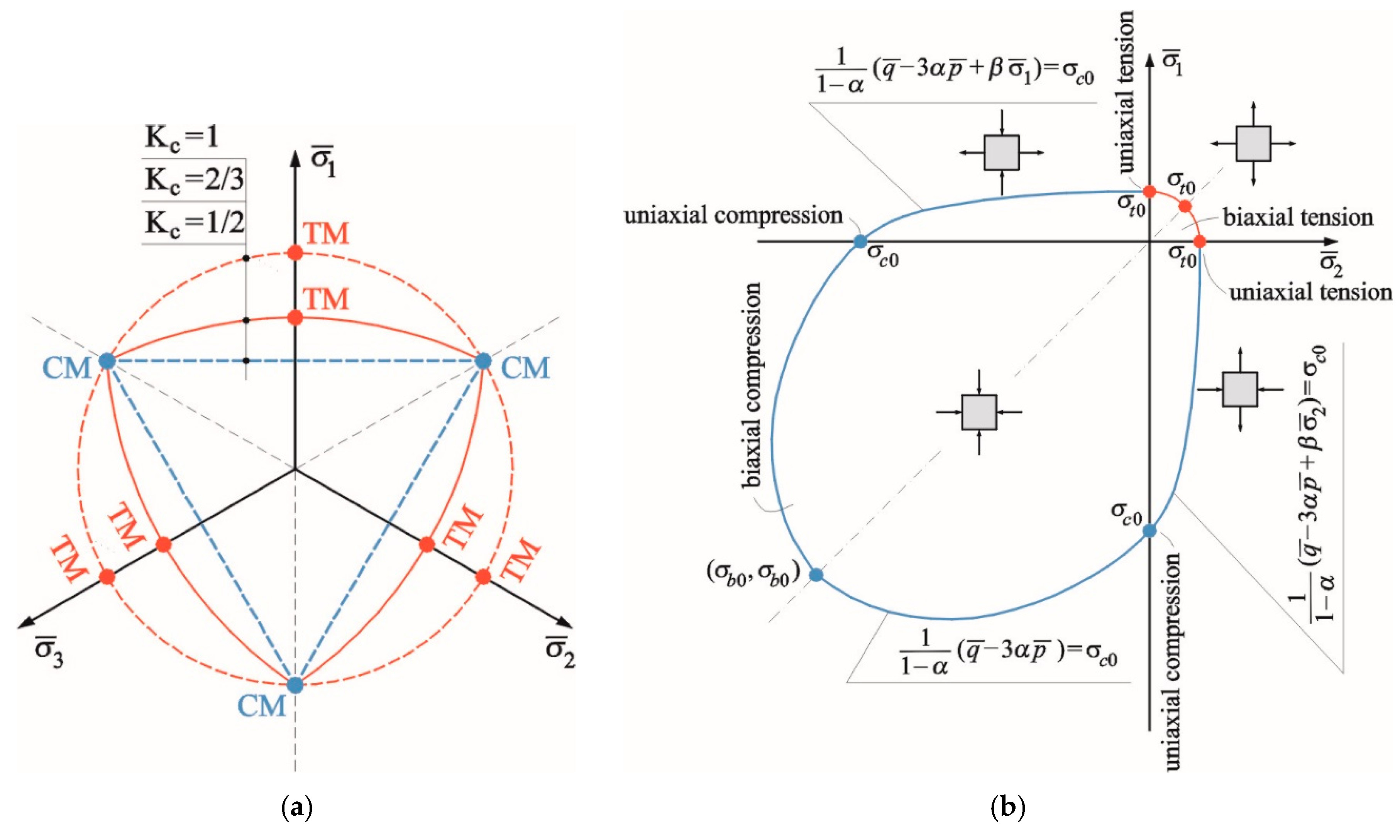
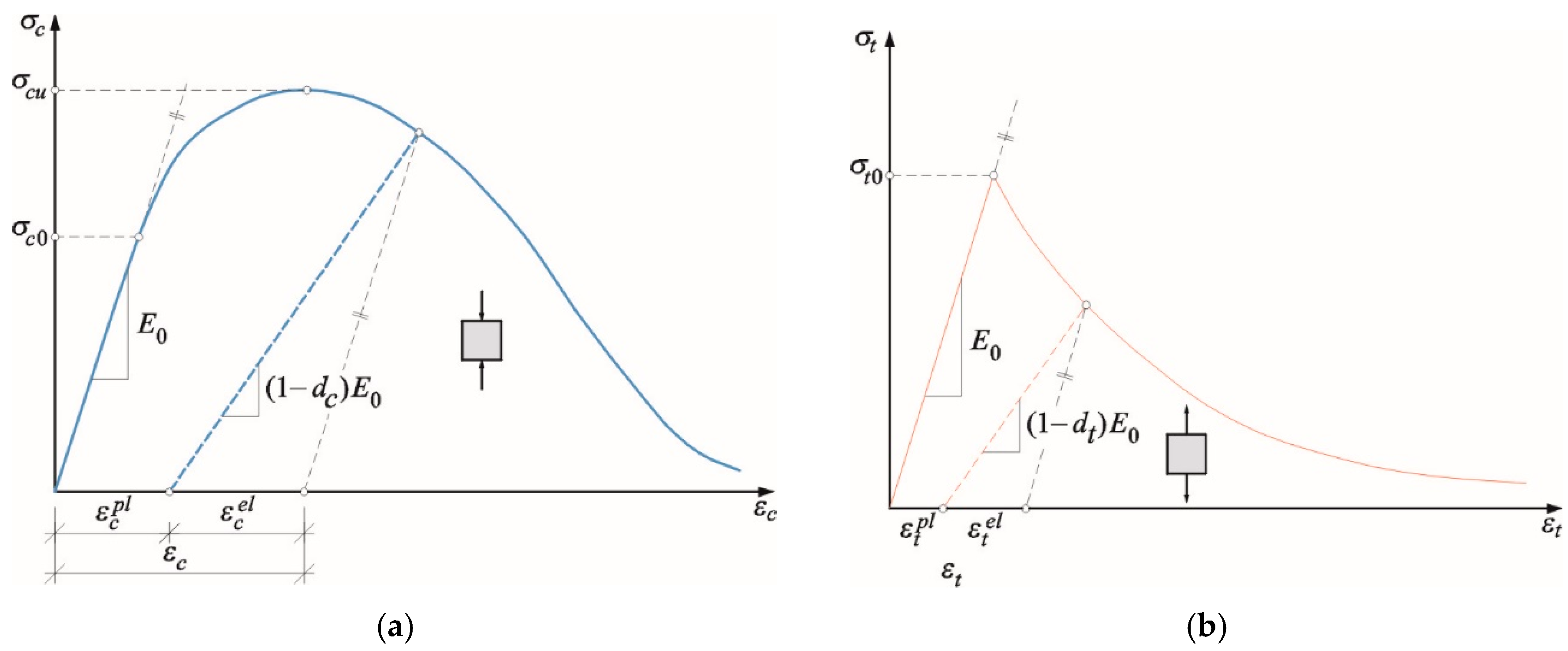

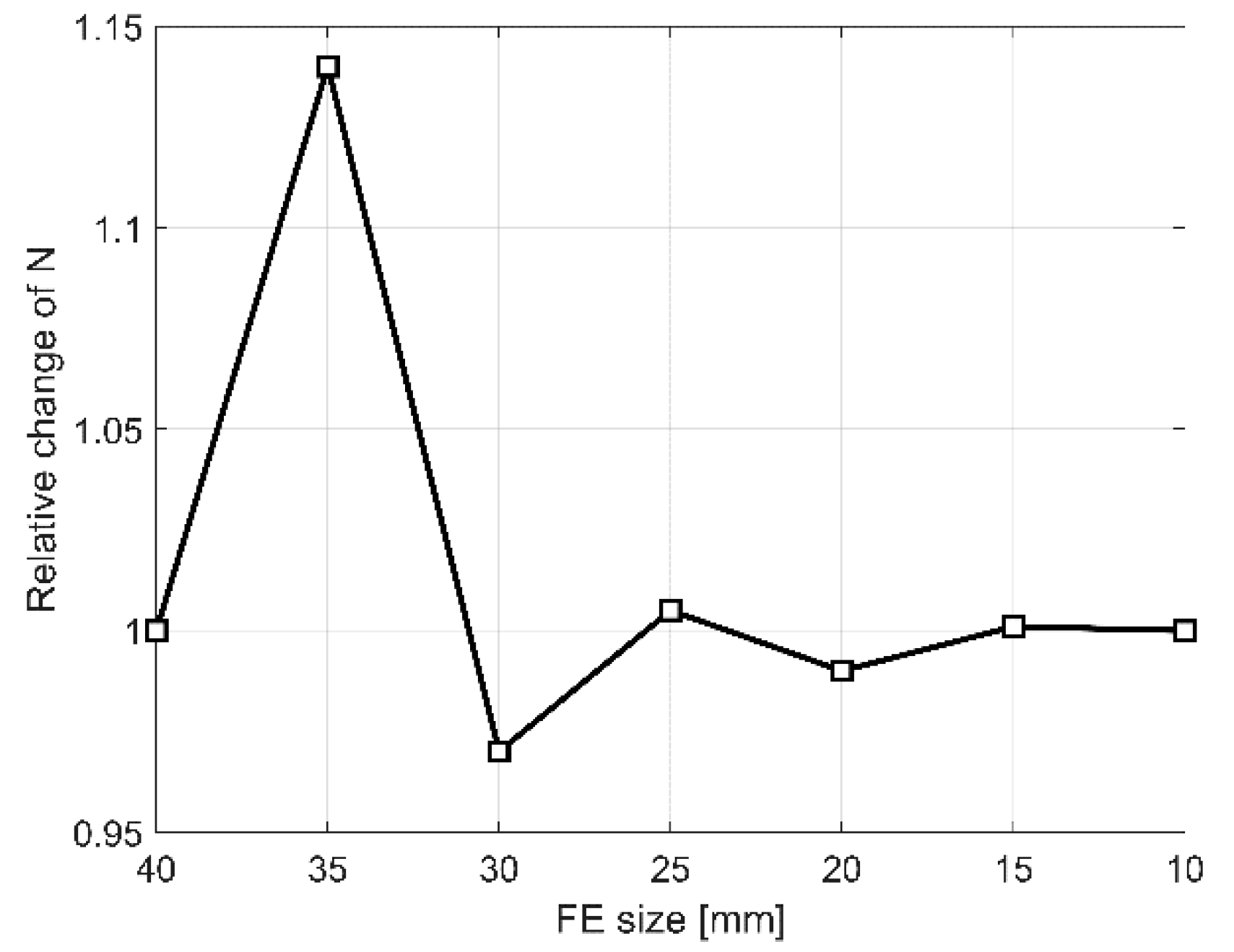

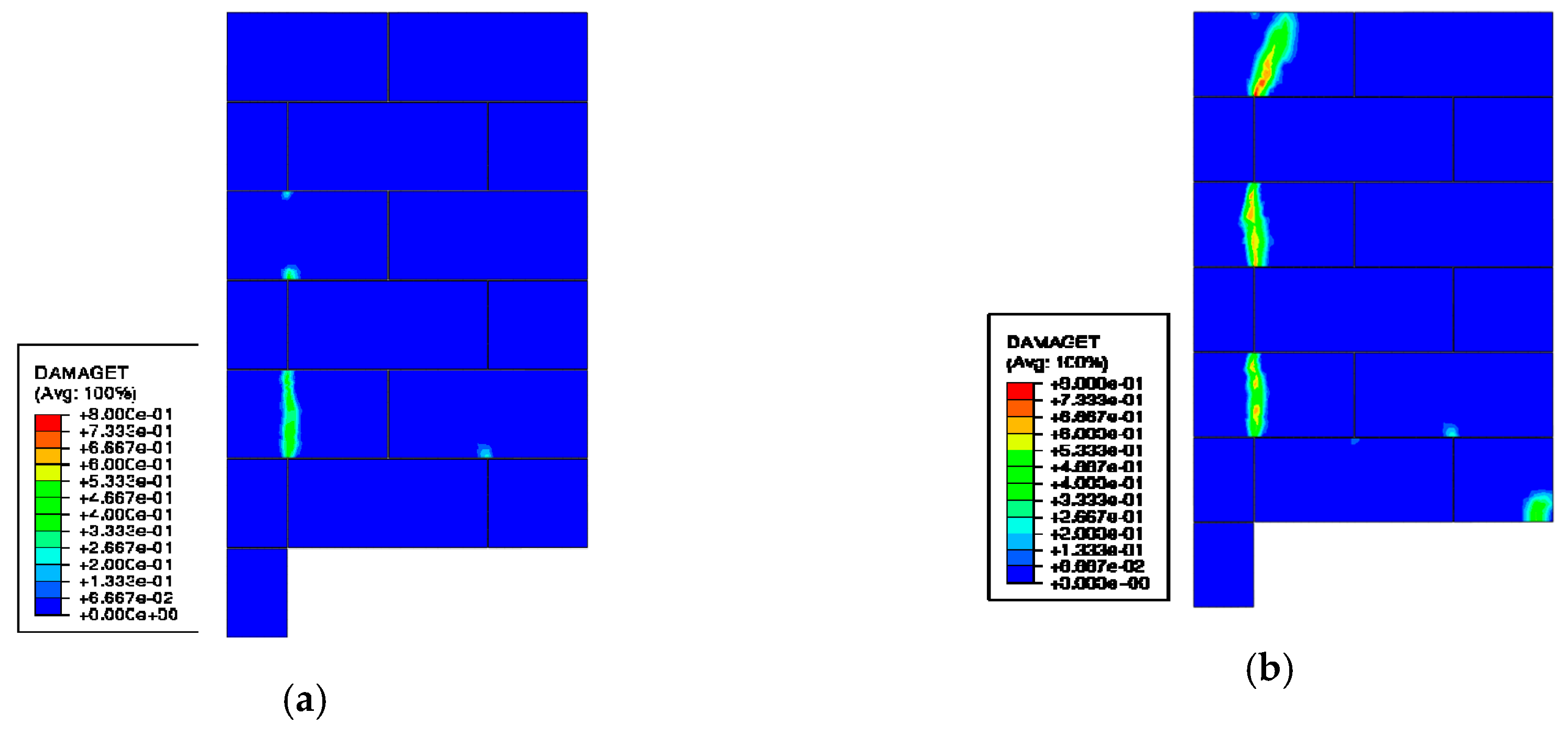
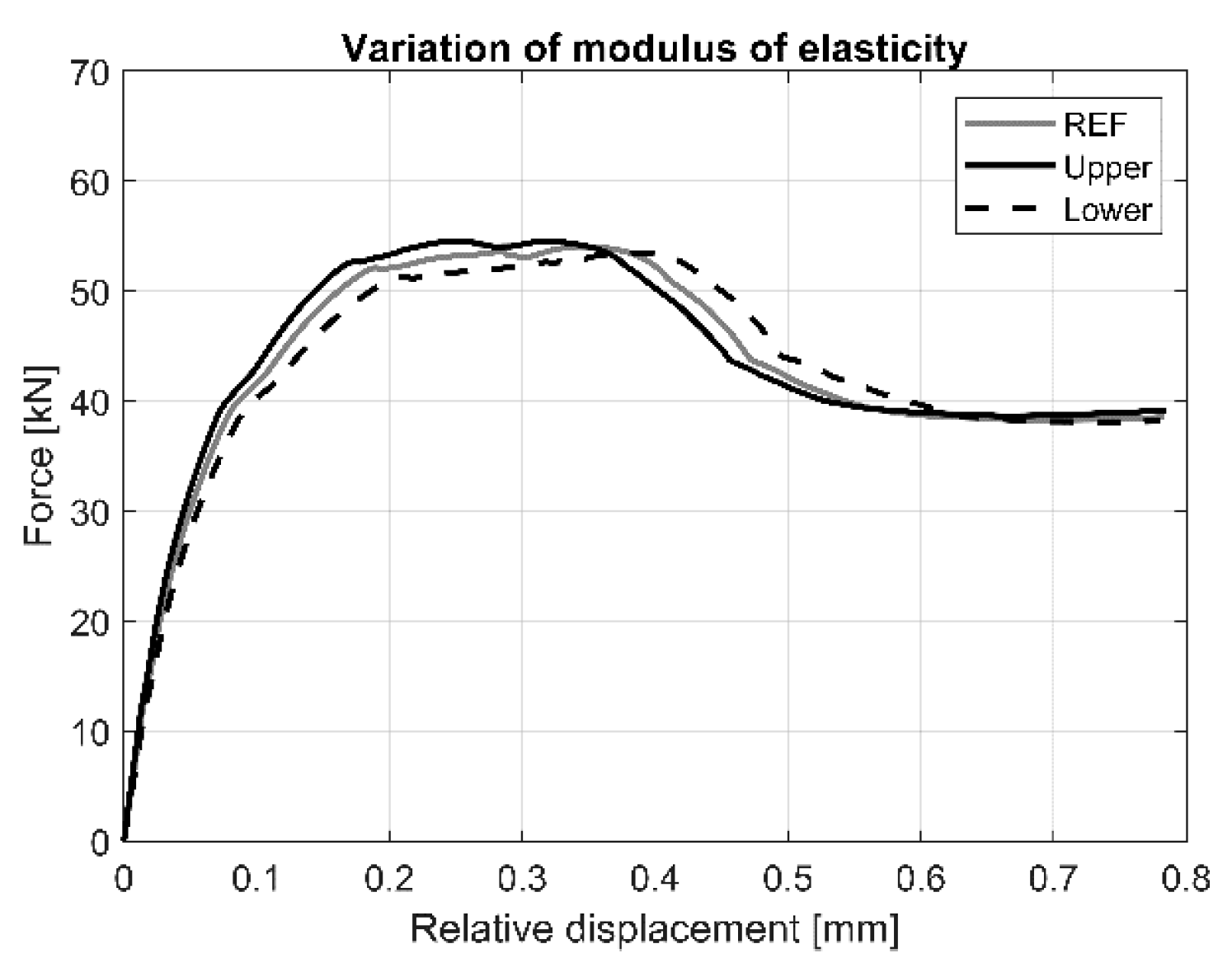

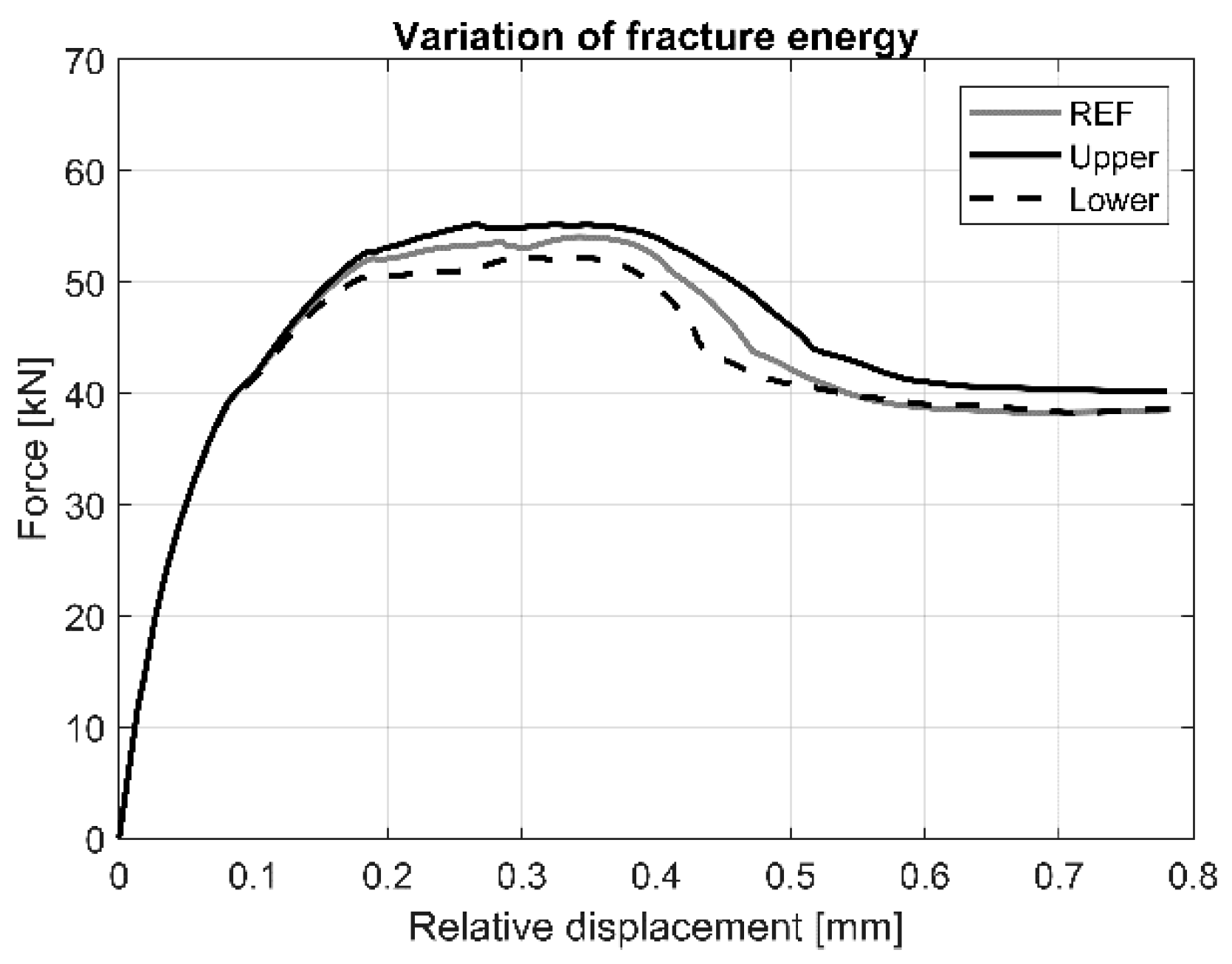
| Sample | Load at First Cracking | Maximum Load | Relative Displacement at First Cracking | Relative Displacement at Maximum Load | Joint (Elastic) Stiffness (2) |
|---|---|---|---|---|---|
| Ncr [kN] | Nmax [kN] | ucr [mm] | umax [mm] | Kel [MN/m] | |
| P-1 | 27.3 | 56.3 | 0.07 | 0.31 | 625 |
| P-2 | 42.6 | 50.0 | 0.12 | 0.25 | 625 |
| P-3 | 31.2 | 38.6 | 0.12 | 0.16 | 588 |
| P-4 | 54.1 | 59.8 | 0.07 | 0.17 | 625 |
| P-5 | 35.1 | 48.1 | 0.06 | 0.10 | 714 |
| P-6 | 45.1 | 51.6 | 0.08 | 0.36 | 1000 |
| Average | 39.5 ± 9.0 | 50.7 ± 6.7 | 0.09 ± 0.02 | 0.23 ± 0.09 | 696 ± 141 |
| Material | Density [kN/m3] | Elastic Modulus [MPa] | Poisson’s Ratio [-] | Compressive Strength [MPa] | Tensile Strength [MPa] | Fracture Energy GfI [N/m] |
|---|---|---|---|---|---|---|
| AAC Mortar | 0.25 16.0 | 28,860 6,351 | 0.20 0.18 | 4.25 5.64 | 0.61 2.03 | 52.152 20.0 |
| Steel | 78.5 | 210,000 | 0.30 | - | - | - |
| Gap infill | 10 | 1 | 0.45 | - | - | - |
| Dilatation Angle Ψc | Eccentricity | σb0/σc0 | Kc | Viscosity |
|---|---|---|---|---|
| 35 | 0.1 | 1.16 | 0.667 | 0 |
| Sample | Load at First Cracking | Maximum Load | Relative Displacement at First Cracking | Relative Displacement at Maximum Load | Joint Stiffness |
|---|---|---|---|---|---|
| Ncr [kN] | Nmax [kN] | Ucr [mm] | umax [mm] | Kel [MN/m] | |
| EXP (average) | 39.5 | 50.7 | 0.09 | 0.23 | 696 |
| FEM | 39.5 | 54.0 | 0.08 | 0.37 | 788 |
| FEM/EXP | 1.01 | 1.07 | 0.92 | 1.64 | 1.13 |
| Elastic Modulus [MPa] | Poisson’s Ratio [-] | Compressive Strength [MPa] | Tensile Strength [MPa] | Fracture Energy [N/m] | |
|---|---|---|---|---|---|
| Variation | ±10.5% | ±8.5% | ±7.3% | ±14.0% | ±15.0% |
| Model | Load at First Cracking | Maximum Load | Relative Displacement at First Cracking | Relative Displacement at Maximum Load | Joint Stiffness |
|---|---|---|---|---|---|
| Ncr [kN] | Nmax [kN] | ucr [mm] | umax [mm] | Kel [MN/m] | |
| MREF | 39.55 | 54.04 | 0.08 | 0.37 | 788.46 |
| MMOE,Upper | 39.55 (1.01) | 54.56 (1.01) | 0.07 (0.88) | 0.32 (0.86) | 909.09 (1.15) |
| MMOE,Lower | 39.49 (1.00) | 53.46 (0.99) | 0.09 (1.13) | 0.39 (1.05) | 714.29 (0.91) |
| MFT,Upper | 44.01 (1.11) | 56.54 (1.05) | 0.10 (1.25) | 0.37 (0.92) | 788.46 (1.00) |
| MFT,Lower | 35.59 (0.90) | 51.14 (0.95) | 0.07 (0.88) | 0.31 (0.84) | 788.46 (1.00) |
| MGF,Upper | 39.55 (1.00) | 55.19 (1.02) | 0.08 (1.00) | 0.37 (1.00) | 788.46 (1.00) |
| MGF,Lower | 39.55 (1.00) | 52.23 (0.97) | 0.08 (1.00) | 0.31 (0.84) | 788.46 (1.00) |
© 2020 by the authors. Licensee MDPI, Basel, Switzerland. This article is an open access article distributed under the terms and conditions of the Creative Commons Attribution (CC BY) license (http://creativecommons.org/licenses/by/4.0/).
Share and Cite
Kozłowski, M.; Galman, I.; Jasiński, R. Finite Element Study on the Shear Capacity of Traditional Joints between Walls Made of AAC Masonry Units. Materials 2020, 13, 4035. https://doi.org/10.3390/ma13184035
Kozłowski M, Galman I, Jasiński R. Finite Element Study on the Shear Capacity of Traditional Joints between Walls Made of AAC Masonry Units. Materials. 2020; 13(18):4035. https://doi.org/10.3390/ma13184035
Chicago/Turabian StyleKozłowski, Marcin, Iwona Galman, and Radosław Jasiński. 2020. "Finite Element Study on the Shear Capacity of Traditional Joints between Walls Made of AAC Masonry Units" Materials 13, no. 18: 4035. https://doi.org/10.3390/ma13184035
APA StyleKozłowski, M., Galman, I., & Jasiński, R. (2020). Finite Element Study on the Shear Capacity of Traditional Joints between Walls Made of AAC Masonry Units. Materials, 13(18), 4035. https://doi.org/10.3390/ma13184035







